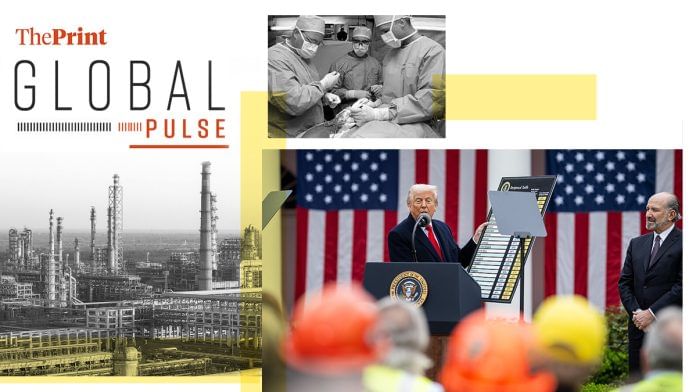New Delhi: “Threats”, tariffs, and now the United States has announced a string of sanctions on two of Russia’s largest oil firms—Rosneft and Lukoil; meanwhile, India has continued to purchase Russian crude. The fall-out from the latest sanctions, however, might persuade India to stop buying discounted oil from Russia, reports Alex Travelli for The New York Times.
“The move could convince India’s private businesses and government-owned oil companies that it is time to quit buying oil from Russia, in a way that threats and tariffs did not,” writes Travelli. “Muyu Xu, a senior crude oil analyst based in Singapore for Kpler, a market research firm, wrote that the sanctions were expected to ‘trigger a decline in exports’ almost immediately, as the Indian companies that buy the targeted Russian firms’ oil consider how they might be affected.”
Duttareya Das, who used to work at a national oil company in India, tells the NYT that this could mean “going back to old times”, as “exposure to Middle East supplies would increase”.
According to the report, India’s statements regarding Russian trade so far have mostly entailed “political posturing”.
“Before the sanctions on Rosneft and Lukoil, Kpler’s analysts noted that Mr Trump’s claims that Mr Modi had agreed to end India’s trade in Russian oil looked like ‘political posturing’. Whatever Mr Modi and Mr Trump have discussed—Mr Modi acknowledged only receiving Diwali greetings and talking about the need to stand up to terrorism—there has been plenty of posturing from both sides since August,” it says.
The Financial Times deems the US’s move as the “most severe measure yet” against the Russian economy, also asking whether India is truly prepared to stop buying Russian oil.
“Historically, India has been less willing to buy US-sanctioned barrels from countries such as Iran than China. The Nayara refinery in India, which is backed by Rosneft and already sanctioned by the UK and EU, will probably face further pressure,” explains the FT. “The biggest question mark is over the behaviour of Chinese companies, including independent and state-backed refiners that may hope they are better positioned to ignore US threats.”
Reporting on Trump’s clampdown on immigration, another piece in The New York Times lays it out straight. The report—“India’s Most Valuable Export: Tens of Millions of Workers”—delves into India’s “teeming population of able-bodied workers”, as the country toggles between the global anti-immigration movement and its massive workforce.
“‘My dream is to go to Japan’, said Vanlal Peka, the son of a pig farmer in Mizoram, a hilly region on India’s border with Myanmar. The dream took him to a warren of glass-walled rooms in a New Delhi basement, where he studies Japanese at the Furusawa Academy. Mr Peka, 21, wants to win a new visa for semiskilled foreign workers and become an auto mechanic in Japan by April,” says the report. “The movement to find new labour markets for Indians like Peka is gathering pace as the United States, long a favoured destination for skilled workers, clamps down on all kinds of migration.”
Developed companies stand to benefit from India’s labour market, with Japan and Germany emerging as the top destinations, according to the NYT.
“If it works as intended, migrants work three- or five-year stints without changing citizenship. The host countries stave off economic stagnation. For India, the temporarily expatriated workers will keep sending home remittances—they already send $135 billion a year—and bring back the capital and know-how it takes to spur enterprise in their own country,” says the NYT report.
Emirates NBD is due to buy a 60 percent stake in the Reserve Bank of India, marking the “largest cross-border acquisition in India’s financial sector”, writes Veena Venugopal in the Financial Times’ India Business Briefing.
“The more significant part of this announcement, though, is what the RBI is signalling. If approved, this would be the second instance this year of the central bank allowing majority foreign investment in an Indian bank, after Japan’s Sumitomo Mitsui Banking Corporation bought 20 percent of Yes Bank in May. Previously, the RBI also allowed some investments by Singapore’s DBS and Canada’s Fairfax in Indian banks,” she writes.
“Though India allows up to 74 percent foreign investment in private banks, the shareholding of any single foreign investor is usually capped at 15 percent.”
The BBC reports on a seldom-discussed area: rural healthcare in the US. It is the rural areas that Trump’s H-1B fee hike will likely hit the hardest.
“Some 25 percent of doctors providing care in the US are foreign-trained. Recent data shows that 64 percent of them practise in the vast, underserved rural areas, where American graduates are reluctant to work, filling a crucial gap in the country’s healthcare system. Many of these doctors are on H-1B visas, and some even spend their entire careers on them as they wait for a green card, making them vulnerable to unexpected job losses and long-term instability,” says the report.
The American Medical Association (AMA) has written to Homeland Security Secretary Kristi Noem, stating that the H-1B fee hike could be detrimental, and “could discourage hospitals from hiring H-1B doctors, affecting future supply pipelines and limiting patients’ access to care in communities that need it the most”.
The BBC report also highlights a crucial point. Indian doctors on H-1B visas are not taking American jobs. Instead, they are “filling critical gaps in care”. One in every five immigrant doctors in the US is from India, according to the BBC.
(Edited by Madhurita Goswami)
Also Read: Trump, Modi & the Russian oil mystery, and rise of RSS from ‘fringe to mainstream’







RBL not RBI